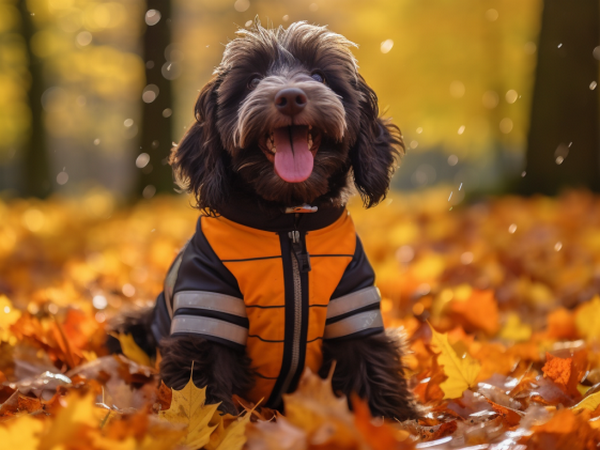Vet's 10 autumn tips for dog owners
The nights grow dark and the leaves go brown and yellow, there’s more rain than you’d like but still, there’s something lovely about autumn, right?
Let's look at how to keep your dog safe and comfortable during this season.
1. Stay visible on walks
In an ideal world, you'd walk your dog before dark — but as the days get shorter during the lead-up to winter, you may not have a choice.
To stay visible to drivers, cyclists and other people out walking, consider getting some reflective or high-visibility clothing for you and your dog. Beyond reflective gear, LED collars, leads and harnesses are a great way to ensure your pet can be seen in the dark, making those evening walks much safer.
You can also get quirky flashing lights to attach to your dog’s collar. This will help you keep an eye on them when you’re out and about.

2. Acorns and conkers
Autumn brings with it some unique hazards that dog owners should be aware of. Acorns and conkers can be harmful if ingested by your dog. Wild mushrooms are another concern — while some are harmless, others can be highly toxic. It's best to steer clear of areas where these grow or keep your dog on a lead during walks in woodland areas.

3. Fight those fleas
Many of us switch our central heating back on during the autumn, which is great news for pesky fleas. As it gets colder outside, fleas will make their way inside — getting comfortable, laying their eggs onto your dog's fur. The eggs will then fall off and lurk in your carpets and beneath other nooks and crannies. They'll pass from the pupae stage to the larvae stage and become bloodthirsty adult fleas before you know it.
Luckily, you can prevent this by making sure your dog is up to date with their parasite prevention treatments. Remember if your dog does get fleas, you'll need to treat your house too. Read more on how to check your dog for fleas.
Read more: Everything you ever wanted to know about dog mites
4. Be wary of antifreeze
If your dog ingests antifreeze, they're at serious risk of acute kidney failure or even death. Pets enjoy the taste of antifreeze (especially cats) so it's important to keep it well out of their reach. If you spill antifreeze, be sure to clean it up immediately.
Symptoms of antifreeze poisoning include:
- Vomiting
- Depression
- Seizures
- Difficulty breathing
- Generally appearing uncoordinated
If your dog shows any of these signs, contact your vet right away.
5. Watch out for rock salt
If ingested, rock salt (or road grit) can cause dehydration and liver failure. To protect your dog from rock salt poisoning, make sure you wipe their feet and paws thoroughly after a walk.
6. Maintain your dog's healthy weight
With the dark nights and the cold, wet weather, our dogs' walks are usually shorter during the autumn and winter months. This could increase their risk of weight gain.
To prevent your dog gaining weight, try monitoring their food intake. Stick to their recommended food allowance and avoid giving them too many treats or scraps. Compensate for their reduced exercise by playing some fun indoor games — this will help to keep your dog's mind occupied too.
Read more: All your puppy vaccination questions answered
7. Keep your dog warm, especially if they're elderly
Older and thinner dogs feel the cold more than most.
A dog jacket will keep them warm and toasty when they’re out on walks. Also, when you get home from a walk, make sure you dry off your dog thoroughly. At home, supply plenty of bedding, and aim to keep your dog's bed in a room that's warm, well-insulated and draught-free. This is especially important for dogs with arthritis.

8. Autumn events
Autumn is home to plenty of events that dogs may find stressful, but you can limit anxiety in your dog by planning ahead. Halloween and Guy Fawkes Night, for instance, come with noise and disruptions that can be unsettling for dogs. Creating a quiet space for them or keeping them indoors can help ease their stress.
9. Seasonal canine illness
Seasonal canine illness has been on the radar of vets since autumn 2010. This perplexing condition tends to affect dogs who walk in woodland areas between August and November. Symptoms can include vomiting, diarrhoea, and muscle tremors, These typically appear within three days of the woodland wander. Should your dog show any of these signs, call your vet straight away.
10. Harvest mites
Harvest mites can become unwelcome guests on your dog's skin during late summer to early autumn, particularly favouring thinly haired areas like paws and ears. They cause significant itching, leading to nibbling, licking or scratching by your dog, which can result in redness or even infections.
Although unproven, links have been made between harvest mites and seasonal canine illness. Treatment for mite infestations is available through your vet. But regular grooming and post-walk inspections can help keep them at bay.
Need more advice?
For more info on keeping your dog safe, happy and healthy during autumn, have a chat with your local vet. Find your nearest vet using our find a vet page, or speak to a vet online using our online vet service .


